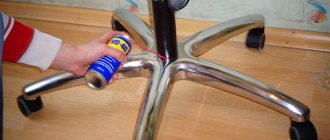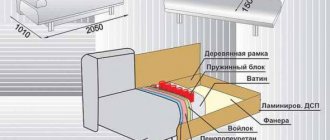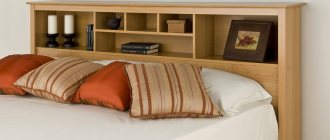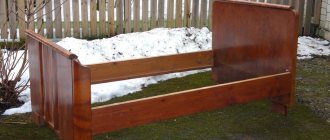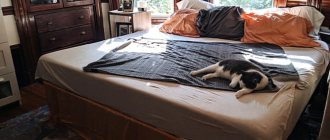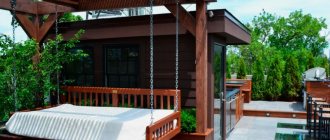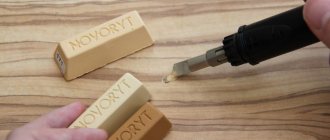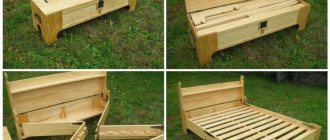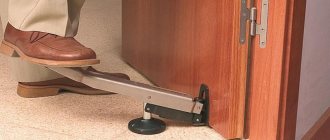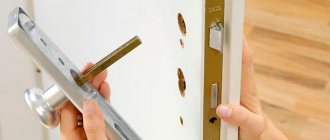If a wooden bed creaks
A bed on a wooden base can cause a lot of trouble by squeaking if the parts have dried out or, conversely, become saturated with moisture in a damp room.
Loss of the product’s shape leads to an increase in cracks and gaps and the appearance of “bed songs”.
You need to start the inspection by checking the place where the bed is installed: it often happens: it is on an uneven floor, so it is enough to find a suitable place and move it to a smooth surface to get rid of the annoying “music”.
A spring mattress can be a source of unpleasant sounds. Experienced home craftsmen advise checking it by laying it at various points: it is possible that the location of the problem will be discovered.
It is believed that it can be removed with a simple movement: simply turning the mattress over to the other side. However, if the “sound” is strong enough, it is better to exchange the product.
When the bed is used for a long time, it has:
- legs may become loose and give way;
- the wooden structure becomes less stable, and the creaks become louder.
You can eliminate them in several ways:
- if the fastener is loose, solving the problem is quite simple: you need to tighten it with wrenches;
- rub the joints with paraffin, soap or silicone;
- Fill large gaps with pieces of thick fabric or leather.
However, the most effective is the use of special rubber glue or metal staples, depending on the nature of the damage.
The peculiarity of the method of working with glue is that:
- the structure will have to be completely disassembled;
- Carefully apply glue to each part and let it dry a little;
- connect all structural elements, pressing them tightly;
- return the fastener to its place.
At the same time, you should not forget that it will no longer be possible to disassemble a wooden bed after thorough gluing.
What to do with a chipboard floor?
If the chipboard was laid without gaps between adjacent elements and walls, then to get rid of the creaking, it is enough to widen the gaps with a circular saw
It is important to know that there are no metal fasteners in the path of the tool.
The second possible reason for a chipboard floor squeaking may be that the slabs used are of insufficient thickness. To eliminate the cause of such unpleasant sounds from the coating, it is enough to lay another layer of chipboard or plywood boards with your own hands. This can only be done if the lag pitch is no more than 60 cm. Otherwise, you will have to disassemble the covering and install additional lags.
If the chipboard floor creaks due to the deflection of the slabs, then you can get rid of the noise in the following way:
- In the area where the floor creaks and sags, we dismantle the floor covering.
- Using a circular saw, cut a square of 50x50 cm or 60x60 cm in the chipboard board.
- We insert bars of the required thickness into the resulting hole so that they can be seen in the gap.
- Next, we install the removed section of the chipboard in place and fasten it with self-tapping screws to the bars placed underneath.
- We putty the seam and lay the floor covering back.
Bed with lifting mechanism
Despite the fact that most beds are stationary wooden, you can find products with a lifting mechanism on sale.
This design can be a source of squeaking if:
- there were problems with the condition of the foundation;
- There is something wrong with the lifting mechanism.
In the first case, you can get rid of the unpleasant “music” only by contacting the manufacturer to replace the base - there are no other options.
It is usually enough to lubricate the mechanism itself with silicone, and if necessary, tighten the fastenings.
Eliminating the creaking of a metal bed
A metal bed can also upset you with extraneous sounds, but eliminating squeaks is quite possible; the main thing is to correctly identify their source.
- Loose mechanisms - Replace with conventional fasteners
- Contacting surfaces – Wrap with plastic wrap
- Armor mesh - Replacement or treatment with a special agent
Experts say that there are not many options for repairing metal beds:
- Tightening fasteners at the connection of parts; In this case, special attention should be paid to the engraving washer, which should protect the nut from unwinding. In its absence, the joints weaken very quickly. If for some reason it is not there or it is broken, it must be installed, which will ensure the reliability of the fastener.
If the source of discomfort is the metal lattice (mesh), which is still found on old beds, you can try lubricating it, although the likelihood that it will stop squeaking is extremely small.
To reduce the “sound accompaniment” of sleep, you can:
- file the legs, making the bed slightly lower, this will reduce squeaks;
- Place a plywood sheet under the mesh - the result will significantly soften harsh sounds.
Advice. A sheet of plywood can be installed if there is a bulkhead under the mesh: without it, it will not last long.
If your legs creak
Quite often the source of squeaking is the legs. There are many reasons for the appearance, but the most common are:
- too large constant loads on the surface of the berth, which can lead to deformation of the part or its complete destruction;
- weak fastening.
The most rational solution is to tighten the connection of parts; this must be done carefully.
Attention! When tightening the nuts, be careful not to overdo it: if you overtighten the connection, the side of the bed or the leg may break.
Frame repair work
The frame repair process depends on the material from which the bed is made:
- If the base of the bed or the entire bed is a metal structure, then the fasteners should be tightened. You need to figure out what size the nuts and bolts are, choose a specific wrench, and tighten them with ease. At the same time, it is worth lubricating with a special lubricant, or Vaseline.
- Such tightening is not suitable for wooden ones. After all, old models are fastened not with bolts at all, but with nails, and boards that cause creaking are very difficult to tighten, but you shouldn’t give up lubricant.
Take note: to tighten it, you need to use a wrench of the right size, because you can damage the edge of the nut or bolt, and then you won’t be able to unscrew them without special tools.
Determining the cause of the squeak
- Remove the mattress and orthopedic base from the bed. Remove the mattress and orthopedic base from the bed. An orthopedic base is a special base made of wooden planks, which is located under the mattress. Place the mattress and orthopedic bed base on the floor.
- Check if the mattress is squeaking. You'll want to make sure that the mattress itself isn't the source of the squeaks before you move on to checking the bed frame. Climb onto the mattress and move around a little, if you hear a squeak, then the cause of the squeak is the mattress.
- Check the orthopedic bed base for squeaks. Press down on it from above and try to wiggle it. If you hear a creak, it is probably the orthopedic base that is causing the problem, not the bed frame.
- Rock the legs of the bed and listen carefully. Squeaking often occurs at the joints between the bed legs and the rest of the bed frame, so try wiggling each leg. Try to find the exact location where the squeak is coming from.
- Rock the support bars at the bottom of the inside of the bed frame. The support strips can be wooden or metal; they are located at some distance from each other and stretch from one side of the frame to the other. An orthopedic base and mattress are then placed on them. Press down on each support bar to check if they squeak.
Often the cause of squeaking is the friction of one wooden part against another.
Creaking sounds of wooden structures
If an old wooden sofa creaks, there may be several reasons.
Each individual case has its own reason for the “musicality” of the object.
When upholstered furniture (sofa), wooden or metal, creaks, you need to arm yourself with tools.
The most likely of them:
- drying out of any part and the appearance of cracks;
- the spring block is deformed or one of the springs is bent (broken).
When you decide to figure out why your sofa is squeaking, you need to gain some knowledge about the structure you're dealing with.
Wood loses its elasticity over time. Its structure is changing. While some tree species are resistant to moisture (for example, aspen), others can be quite fragile and quickly fail. Much depends on the correct use and care of the product. Both one panel and all wooden parts can dry out if normal humidity conditions were not observed during operation or the furniture was placed in direct sunlight.
Sometimes creaking is characteristic of a new product when the connections are poorly fitted, sometimes this appears after prolonged use.
The sofa needs to be disassembled before work.
The cause may also be loose (or too tight fasteners). The sofa makes a characteristic grinding sound. It is also possible for the padded batting or other soft upholstery material to become thin and deformed in other ways.
The reason could be a spring block rusted from moisture, wood that has dried out over time, and much more.
It is necessary to examine the internal state of the furniture and determine the location of the creaking noise.
If old wooden furniture creaks, you will need to replace the spring unit or its parts. The first is preferable, since we are talking about wear of the material as a whole, and then another spring or section may break. Connecting individual links is quite labor-intensive work.
Wood loses its elasticity over time.
One reason may be wear and tear of the soft cushioning material. Over time, due to humidity, they could rot and turn into dust, creating access for the connecting elements to each other, which is why the creaking occurred.
Much depends on the correct use and care of the product.
To correct the deficiency, prepare the tools.
A product that is too old is a little more difficult to tidy up. To determine the exact cause, the sofa should be carefully disassembled. It is likely that replacing elements or lubricant will be sufficient. Otherwise, you may need to buy new furniture.
The cause may also be loose (or too tight fasteners).
Quick ways to fix problems
Line the frame support strips with old clothing. Use old socks or shirts that you no longer wear for this purpose. The fabric will not allow the orthopedic base or mattress to rub against the bed frame and make squeaks.
Use cork caulking to fill excess gaps in a wood frame bed.
- Check the bed for any gaps where the orthopedic base or mattress could potentially ride and rub against the bed frame. Place cork sealant in these gaps to ensure all bed components fit together tightly.
- Slide a towel under the uneven legs of the bed frame. A bed foot can be considered uneven if it does not touch the floor. Slip a towel into the gap between the corresponding leg and the floor to prevent the bed from rocking and making unnecessary sounds.
- Place a book under the mattress near the source of the squeak. If the creaking comes from the support bars, remove the mattress and orthopedic base from the bed, and then place the book on the creaking bar. Then return the orthopedic base and mattress to their place.
Determining the source of the squeak on the bed
Of course, it will be better to work in pairs, since it will be inconvenient for one person to “wobble” the bed and listen to sounds. To calculate the seats, you need to lie on the bed and turn over, simulating a standard night's rest. At this time, your partner should listen to where the creaking is coming from.
It often happens that the source is in the joint of the corner frame or in the places where the legs come into contact with the base of the bed - how to get rid of a squeaking bed.
- To fix the squeaking of the bed, we will need open-end or adjustable wrenches if the connection is bolted, or a screwdriver if there is a screw connection. Try to tighten all the connections, but not too much, so as not to crush the wood. If the bed continues to squeak, then you should look for other sources.
- It happens that the mattress rubs against the bed - try to level it so that it does not come into contact with the walls of the frame. If the problem is not corrected, you need to move on to an orthopedic foundation. Remove the mattress from the bed to the floor and check it at the same time; sometimes the springs creak.
- Lie down on the slatted base and fidget a little; the slats can creak from the pressure on them as your body moves. The bed creaks, what should you do? You can fix the creaking with WD-40. To do this, you need to carefully spray all the connecting places of the bed before tightening the bolts and nuts.
Creaking in different places
Unpleasant sounds can come from different parts of the sleeping area:
- In the corner. During rocking, sounds very often begin to come from the corner of the berth, where two drawers (wooden boards) are connected. After all, if the whole bed sways, then so do the legs. Because of this, wooden parts begin to rub against each other.
- Lifting mechanism. It is the wear of the rocker mechanisms that are used for lifting that can cause the bed to become squeaky. If there is a wardrobe bed, then the source of the squeak may be a spring block or frame.
- In the head area. The sounds of a gas elevator or lifting mechanism can be heard. Many people in this case try to get rid of the problem with the help of oil and a regular candle. But simply lubricating it is not enough; for a short period, of course, it will help, but you won’t be able to completely get rid of the squeak.
- Leg. It is not at all surprising that the higher it is, the more sounds it will make. Accordingly, in “legless” models there will be no such problem. It can be eliminated by adding metal corners to the structure or replacing old legs with new ones.
- Lamels. Creaking can be produced by bent-glued planks, the base material of which is wood. They form the basis of many beds. They can be lubricated or gaskets placed at the points of attachment to the frame.
Technician's note: identifying the location of the squeak will allow you to quickly fix the problem.
But the sound can be heard in several places at once. There are a number of steps you need to take to get rid of them. It is not so difficult to do this without the help of masters.
It is worth noting: if the bed creaks at a certain time of the year, this is due to climatic conditions. And if this phenomenon occurs all year round, then it needs to be eliminated.
Remove squeaks without disassembling the bed
How to remove squeaks using a simple method - you can try to remove squeaking sounds using a chest of drawers and a pillow. You need to do the following:
- Insert a pillow or some other thing between the wall and the headboard, at the headboard.
- Or you can place the bed tightly against the wall and press it with a chest of drawers or an ottoman, so you can straighten a bed that has moved apart.
- If the problem remains unresolved, then you need to move on to another option.
How can you lubricate wood to prevent it from squeaking?
In the event that the pull-up is not
helped and the wooden bed still
creaks
, then you should act differently. All places where the bed elements are joined are treated with a lubricant. As such, you can use silicone grease, soap, grease, baby powder or wax.
Interesting materials:
Where and how to make a health record? Where and when was the second front opened? Where and when was the first exhibition basketball tournament? Where and when was Dahl born? Where and when was the film first shown? Where and when was the novel The Master and Margarita first published? Where and why does Africa receive the most rainfall? Where is Ibrahimovic playing 2022? Where does Igor Makarov play? Where can a website creator look for clients?
Preparation
If the above methods do not give a positive result, then you will have to move on to more serious work - dismantling the creaking bed. To do this, we may need a tool and auxiliary material to lubricate the rubbing particles:
- A set of screwdrivers or wrenches, it depends on the fastener itself;
- Metal corners and screws (wooden reinforcing elements can also be used);
- Paraffin or candle;
- Ski lubricant;
- Graphite grease;
- Litol;
- Laundry soap;
- WD-40;
- Silicone spray;
- Rubber based adhesive.
We prepare all the tools and auxiliary equipment so as not to be distracted in the future.
Treatment of rubbing parts of the bed
When all parts have been removed and inspected, bad screws have been replaced, you can begin processing rubbing parts. To do this, you can take any lubricant and lubricate all the parts with it. This must be done carefully so as not to stain the front part of the furniture.
Of course, liquid and thick impregnations will wear off after some time, and the squeak will appear again, but they will still serve for several years.
And if you use silicone compounds, this sound will disappear for a long time. You can use paraffin, all parts are rubbed, after which everything is put back in place.
There is a more reliable processing method, but it is only considered if you do not intend to disassemble the bed in the distant future. To do this, you will need rubber glue, which will create a reliable flexible gasket and at the same time glue all the processed elements together.
The operating principle is as follows:
- All disassembled parts and joints of the frame are degreased with an evaporating substance, for example, alcohol.
- When the alcohol dries, you need to apply rubber glue to all prepared parts of the bed.
- The frame is immediately assembled, the legs and all other parts are screwed on.
- It is necessary to allow the structure to dry, after which it can be safely used.
But do not forget that such a variation does not imply a secondary disassembly of the bed. There is another option, gaskets - balsa wood. The cork spacer is cut to size and placed between the boards or parts during assembly.
To strengthen the structure, it is recommended to install additional corner fasteners made of metal or wood.
Determining the source of the squeak
To quickly find the source of unpleasant sounds, you need to ask someone close to you for help.
First you need to simulate a night's sleep: lie on the bed, turn in different directions, and at this time the assistant will listen to the place of origin of the sounds.
If a wooden bed creaks when a person moves in a lying position, then the source may be the joints of the legs and the base of the frame, as well as the corner joints of the lounger. Problems can also arise in wooden planks. Even unused slats that are not screwed securely will begin to creak from the first day.
An uneven floor causes the legs to constantly shift, producing an unpleasant grinding noise. Old floorboards may creak, and the sound may seem to be coming from the bed.
- If, after a long search, we couldn’t find anything on the furniture itself, we move on to the mattress. Since he’s just lying on the floor at this time, let’s lie down and try to detect extraneous sounds inside him. This means the problem is in the springs.
- The final source of squeaking is where the mattress meets the base of the bed. To detect it, you need to return the mattress to its place and carefully roll on it. The source of the noise cannot be detected immediately, but only after the mattress is installed in the position that is problematic.
After all search methods have been implemented, you need to proceed to the last stage - eliminating the creaking of a wooden bed.
Radical methods
If the tips above do not help, then you should disassemble the entire bed.
Next, the gluing areas need to be treated to degrease them.
Then glue should be applied to each surface, it is important not to overdo it, because the layer should be thin
Allow time to dry a little, but not dry completely. Then glue all the parts and, of course, fasten them the way they were originally connected. Now we wait for it to dry completely.
If additional reinforcement is needed from the inside, you can also attach metal corners and additional screws. When processing wooden parts of a bed, if there is no glue, then instead you can use a special spray, which is based on silicone.
Very often the cause of unpleasant sounds is the slatted base of a wooden frame.
The boards may wobble or become deformed; you can try turning them over, swapping them, or replacing them.
For work you should prepare so that you have on hand:
- work gloves or mittens;
- prepare soap, wax or a regular candle;
- graphite, silicon or lithium grease;
- rubber glue;
- spray, which is based on silicone;
- tools that can tighten nuts and bolts.
So, if the bed begins to “moan” terribly, do not rush to call a specialist, much less change the bed. Providing yourself with a sweet sleep and eliminating the nasty squeak is a completely doable task that can be solved at home.
You just need to correctly determine the place where the sound originates, equip yourself with the necessary tools and working mood. And then carefully and scrupulously follow the above tips.
Watch the video in which a user demonstrates an effective way to eliminate the squeaking of a wooden bed:
What if the new bed squeaked?
When the furniture has just been purchased, and the question has already arisen of how to remove the creaking of the bed, the situation requires immediate action. In this case, you shouldn’t look for the source of the squeak yourself: such phenomena are most often associated with poor-quality assembly or factory defects.
The best solution is to contact the place where the bed was purchased. Store employees, as a rule, correct defects in the assembly, but if the defect is beyond doubt, the model is replaced with another one.
Thorough elimination of squeaks
If you are not planning to replace the bed, you should try to strengthen its elements as securely as possible. Usually the frame is strengthened with glue in several stages:
- disassembling the frame;
- wiping parts, removing dust and dirt;
- degreasing the surface;
- applying glue to holes and joints;
- connecting parts, assembling the frame;
- leaving the bed until completely dry.
It is also possible to strengthen the structure of the bed with furniture corners - they are attached to the weakest joints and firmly fixed.
How to treat rubbing parts?
If the furniture is in good working order, it is enough to treat the rubbing parts with lubricant to permanently eliminate extraneous sounds. It remains to find out how to lubricate the bed from squeaking - for this you can use:
- paraffin - in the form of a special bar or an ordinary candle;
- laundry soap - for rubbing until completely smooth;
- silicone lubricants - special compositions for treating parts subject to friction;
- WD-40 is an aerosol for short-term lubrication of beds with a metal frame.
If the bed squeaks, you don’t have to immediately think about replacing it. In most cases, the causes of unnecessary sounds can be combated - just carefully examine the entire structure, find the sources of creaking and put a little effort into eliminating them.
How to fix a creaking bed frame
A wooden bed frame usually begins to creak after several years of use. In the dry air of an apartment, wooden elements dry out, their sizes decrease and micro-gaps form at the joints. When loaded, the wooden parts rub against each other, and the contacting surfaces gradually wear away, which further increases the gap. The creaking intensifies.
Advice! If your new bed squeaks, contact the manufacturer. Perhaps this is a manufacturing defect and it is better to replace it under warranty.
The easiest way to eliminate frame squeaking is to tighten the fastening elements: bolts, screws or self-tapping screws. This technique will give a temporary effect, the creaking will decrease or even stop completely, but with a high probability the fasteners will weaken again, and the wear of the wood will increase.
Therefore, when a squeak appears, it is better to immediately resort to fully strengthening the frame.
For small gaps, the use of lubricants has a good effect. Anti-friction lubricants reduce friction and eliminate squeaking of wooden parts, and also reduce their wear. Lubricants are applied to all rubbing areas of the frame. The types of suitable lubricants and methods of their application are indicated in the table.
How to eliminate frame and slats creaking
A frame with orthopedic slats takes on the entire load and redistributes it. That is why it wears out quickly and is often the cause of squeaking. Both the slats themselves and the places where they are fastened - the lath holders - can creak.
First you need to carefully inspect the slats for cracks, chips and deformation. Some of them may need to be replaced.
What can you do if the slats and frame sound?
For beds with slatted bases, a common cause of squeaking is wear and tear on the slats. In this case, both the crossbars themselves and the places where they are attached to the frame - the lath holders - can creak.
If upon inspection it turns out that the creaking comes from the lamellas, you should proceed as follows:
- Inspect and feel each of the planks. If cracks are found, damaged lamellas should be replaced.
- Check the lathe holders. If all the slats are intact, the fastening screws should be tightened. You need to act carefully: if you apply excessive force, the fasteners may crack.
- If the screws are tightened properly, but the slats creak, you need to press on each of the slats in turn. Having discovered a squeaky one, it is taken out of the fastenings and treated at the ends with silicone grease. If the size of the gaps allows, you can instead wrap the ends with a layer of felt or polyethylene foam. Then the bar is put in place - it will no longer creak.
- If there are no lath holders in the design, and the slats are placed directly on the screws, you should unscrew them, put a layer of insulating material (at least the same felt) under the slats, and then put them back on the screws, screwing in 1-2 additional ones next to each other to be sure.
How to eliminate a squeaking mattress
Not only the wooden elements of the bed can creak, but also the mattress, spring or with polymer filling. Sometimes squeaking is caused by an incorrect position of the mattress, in which case it needs to be leveled on the base.
Cheap models of mattresses with dependent springs - blocks - creak due to the friction of the springs among themselves. The creaking of such a mattress will sooner or later arise and can only be eliminated by replacing the mattress.
More reliable and expensive models of spring mattresses are equipped with independent blocks. In them, each spring block is placed in a waterproof case, which plays two roles at the same time: it eliminates friction of the blocks against each other and does not allow moisture and sweat to destroy the steel of the spring, weakening it.
Advice! If a mattress with independent blocks begins to squeak, it needs to be turned over - this will help reduce the load on the worn blocks and temporarily eliminate the squeak.
Springless mattresses filled with polyurethane foam can also make sounds similar to squeaking. This occurs if the seal of individual bubbles of the foamed polymer is broken and air flows from one to another when a load occurs.
The appearance of extraneous sounds in a PU foam mattress indicates that the polymer has lost its properties and it’s time to think about replacing the mattress.
Prevention measures
To prevent a situation when a wooden bed creaks in advance, you should pay attention to simple expert advice. When choosing bedroom furniture, it is recommended to prefer products made from natural and expensive wood. Typically, these models are the most durable, which means they are less likely to break. Breeds worthy of attention:
- Oak is a strong tree that is resistant to external influences. It features a beautiful natural pattern that will fit well into any interior.
- Mahogany is an elite variety with an unusual color, original structure and resistance to ultraviolet radiation. In addition, the material emits an aroma that repels insects that can spoil the wood.
- Rosewood is also a luxury item that exudes a violet scent and, if built well, will last for many years.
Oak
Red tree
Rosewood
Regardless of the type of wood, high-quality assembly of the frame is important so that its elements are connected as tightly as possible without gaps. Before purchasing a bed, you also need to make sure the quality of the slats. It is advisable to choose a mattress with separate blocks that last longer. Regular turning over will help to extend its service life in order to reduce the load on individual parts.
The bed should stand as level as possible; if it is placed at an angle, the frame will be loaded unevenly, which will lead to rapid wear of parts and loosening of elements.
Instead of a wooden bed, you can choose a metal one; it creaks much less often, and most of these problems can be solved with the help of lubricant. In addition, it is worth paying attention to forged models made with a minimum number of fasteners. They look as elegant as possible and do not make any extraneous sounds.
If the bed creaks, there is a problem in its design that should be solved immediately. Problems may be hidden in the base, headboard, frame or even mattress. First of all, you should tighten the fasteners and lubricate them; if this does not help, the reason is more serious. The situation needs to be corrected as quickly as possible, otherwise a minor breakdown will gradually render the furniture unusable.
Mattresses with independent springs are less likely to squeak
The metal frame is durable
